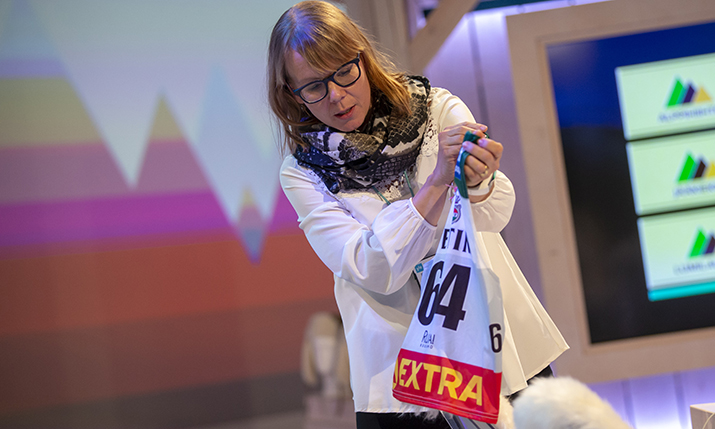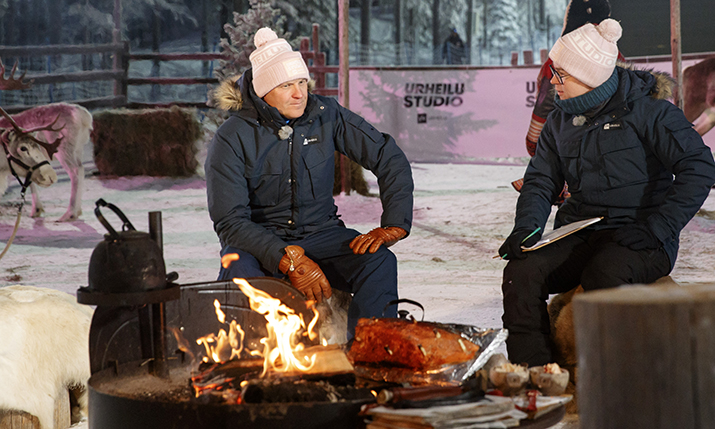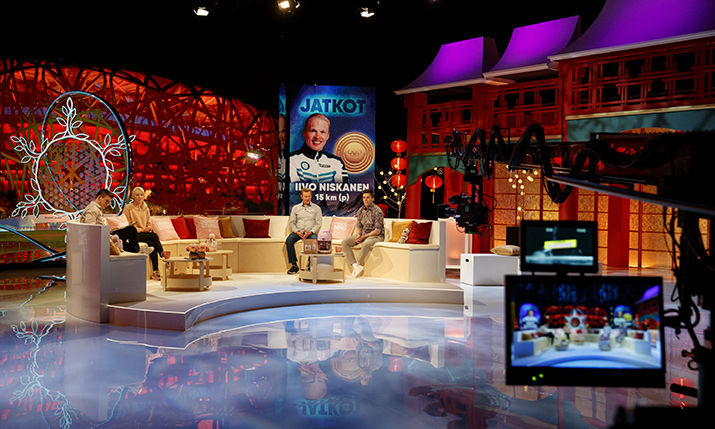A race to the Finnish: The changing face of winter sports coverage at Yle

Public service broadcaster Yle has the rights to broadcast various winter sports in Finland, from the Winter Olympics and the Biathlon World Cup to the Alpine, Nordic Ski, Freestyle and Snowboarding World Cups and World Championships. It offers viewers presentation and analysis as part of its coverage, as well as performing host broadcast duties on local competitions. In this in-depth interview, presenter turned executive producer Kristiina Kekäläinen discusses her career so far, outlines the broadcaster’s winter sports philosophy, and explains how two very different uses of technology have helped engage viewers.
A lot of Yle’s output is based around the Sports Studio. Tell us about it.
“Back in 2018, we knew we had winter sports rights for the next three years. And we knew we wanted to create something with that. Sports Studio brought everything together and it’s a brand nowadays and a concept that we use at the weekend. We have 8 to 10 hours of broadcasting when we combine these events like the World Cup events in winter sports. And, in my opinion, we have changed the way of doing sports journalism with this concept.”
What is the philosophy behind Sports Studio?
“We want people to enjoy it, of course. But we also do the critical things and the analysis part of sports journalism. In a straight translation from Finnish, Sports Studio is a friend that unites sports, Finnish people and the world around them. So there’s no subject that we can’t talk about. There is a big team. It took some time to change the old habits and ways to do things when we started because we wanted to do things differently.”
How does Sports Studio differ from how you previously covered winter sports?
“We used to have the commentators and the experts come to the studio after the events and do the analysis. But we decided we didn’t want to do that because we thought that if the commentator and the expert have been already been in the commentator position, why are we talking about that same stuff in the studio again? We now focus more, for example, on the athletes and their stories. We get closer to them and make the show fun. And we want to be close to the audience and we want them to take part in our shows.”
Can you give us an example of how that manifests itself onscreen?
“Sport still gathers people together. Cross-country skiing, for example. We get to a point where one million Finns or two million Finns are watching the game or the Winter Olympics. But we also look to find a different perspective when we are interviewing the athletes. We don’t just ask “How are you preparing for the upcoming event?”
“We are bringing out the human side of the athletes so that they’re not just the people that are practising a lot and competing a lot. We make them more human.”
“For example, in the Beijing Olympics. The cross-country skier Iivo Niskanen won three medals in cross-country. But his sister runs a bakery. So we invited the sister to bake a cake for Livo’s gold medal and we asked her to come to the studio. And we had Livo in Google Meet straight from Beijing and he had his Olympic gold medal there. And she was like, “Oh, my sister is there!” And she had a cake!
“We are bringing out the human side of the athletes so that they’re not just the people that are practising a lot and competing a lot. We make them more human.”
When you first got this job, you said you were keen to use technology to aid your storytelling and interaction. How have you done that?
“Well, first we used WhatsApp! Really! We created this concept where our experts answer questions that are sent to us during the studio breaks via WhatsApp. And it has been a huge success. It allows us to ask some of the more simplistic questions that the audience wants the answers to.
“At the other end of the spectrum, we have also used quite a lot of AR technology. Before this season started, we captured Kaisa Mäkäräinen, the biathlete, in front of a green screen while she explained her various techniques and tactics. We captured her from 20 different angles and created a graphic that allows the presentation team to talk about Kaisa and analyse her on-air and we can illustrate that using the AR model in the studio. We did the same with Janne Ahonen, who is a former ski jumper.”

What is next for Sports Studio?
“We definitely want to develop the Sports Studio and the winter sports, and go more to the digital platforms. We would like to create a sort of tribe, so it’s Sports Studio’s tribe, a tribe where people could come together before, during and after the competitions. Chatting together along with the event and chat with our experts, commentators and guests. Create a conversation.”
You also do the host broadcast production of domestic legs of World Cup events What do you try and achieve with that coverage?
It’s the story. That is the most important thing. The story from the beginning to the end. When they’re preparing, who are the favourites and who are the dark horses? And that’s very important before the race starts. And then, of course, you have to follow during the race. And afterwards, highlight the ones who succeeded.
You’ve been at YLE since 2002. First as a reporter and presenter, then producer and head producer, and now as executive producer, a role you have held since 2020. Tell us a bit about your journey.
“I went to a high school that specialised in music. When I was very young I played this Finnish National instrument called the Kantele, which is sort of like a harp, but I was also very into sports. I liked cross-country skiing, fitness, baseball, and swimming. And I was following sports with my father. And so it has been a big part of my life from the very early days.
“It was funny. When I went to the special music high school there was a message on the t-shirts that said: ‘Music Saved me from Sports’! And I was in between. I wondered if I was in the wrong place But music and sports, I have a lot of love for both.
You studied communications at University but finding a job in sports broadcasting was an accident, right?
“I went to study in France and I remember that I wanted to a little save money for that trip. So I asked my parents if I could come to stay with them and get a summer job before I went.
“My parents live in a quite small city, and because of my communication studies, I looked at the local newspaper and then the local radio station. I thought then, and I still think it now, that I’m better at spoken presentation than I am at writing. So I applied for a summer job at the radio station and got it. And I really liked it. I was doing the local news.
“I can see the big picture and where we should go. I have strong opinions but I also listen to my colleagues. And I think that I also have a good sense of what the audience wants.”
“Then I went to France. When I got back I saw an ad in a newspaper for a special vocational education course for sports journalists. I applied for it because I wasn’t sure I really liked the radio and I was still searching for what I wanted to do. And because of my background in sports, I thought, why not? I got in and while studying there they opened a job at Yle Sports as a sports journalist. That was how I started.
How did you move up through the company?
“This sounds like another accident or coincidence but there were two quite big sports journalist stars at YEL Sports and they changed jobs. So all of a sudden YLE Sports needed cover. They were big shoes to fill but I was asked to step in and I actually got to be a sports news anchor. It happened pretty quickly.”
Did you face any barriers in making that move?
“No, actually. I think that because I wasn’t the first woman or not one of the first ones. For the audience, maybe there was more of a barrier. Not that they have said that I wasn’t good enough or anything, but when they write to you, [they tell you] what they want to say to you. So they maybe notice different things that they notice or give different feedback to the men than they give to the woman. But inside our company, no, definitely not.”

How did you transition from being a sports anchor, in front of the camera, to being a producer, behind it?
“My first big studio host was from the Beijing Summer Olympics 2008. And after that, I did a lot of these kinds of big sports events as a presenter. I had my first child in 2010 and my second in 2013, and by that time there were also little breaks from the work. And, well, after two children you start to think that, “OK, do I want to travel 200 days during the year around the world?”
“And then I started to do little bits of work as a content producer on smaller sports events. I wasn’t a producer yet. But I was responsible for the content that I was planning: What we should do? What kind of stories? What kind of interviews and stuff like that. Like, for example, in 2017 when I was at the Alpine World Championships in the USA and the Floorball Championships.
“It was nice because I could combine the host job, as well, but being a little bit more responsible for the production, because they were quite small. So we had a small team and, basically, we didn’t need to ask for anything from anybody, but just do a good job and produce good quality content.
“So by that time, I was able to take a little bit more responsibility also for budgeting and for the technical side of things.
“And then, in 2017, I was a producer at the Alpine World Championships in St. Moritz, Switzerland and I was thinking: My first child went to the elementary school for the first grade, and my husband works, as well, at YLE, and he’s a host so, should we make a change?
“It came, basically, from the family and my point of view that maybe I should take another step in my career. And could I be something other than a sports journalist or a host or an anchor?”
What steps did you take next?
“I spoke with my boss and, another happy coincidence, around that time we had just won this big winter sports rights deal and YLE had planned to have a Head Producer for it for half of a year from November to late March. My boss asked, “How would this sound?” And I said “Why not? Maybe this is now the chance to go for it.”
You did that for two seasons. Did you receive any formal training or mentoring along the way?
“I haven’t had any kind of special education. I have been going through step by step on this path. Along the way we have been working as part of teams where we have the technical people and we have the budgeting people and the content team. So I have been seeing that all the time, how the people work and taking step by step my path forward and forward.”
After that, you were promoted to executive producer. What reaction did you get?
“Our current Head of Sport, Joose Palonen encouraged me to apply. I had to ask myself “Am I ready? Do I want to do this?” Because actually, I got a lot of feedback saying, “Don’t go because you’re such a good presenter and anchor and host.” Even my husband was also asking “are you really interested in that? Do you want to lead people and do budgeting things?”
But you made the move. And now you are responsible for both the winter sports and digital development. What are your strengths? What does the role require, from your perspective?
“I can see the big picture and where we should go. I have strong opinions but I also listen to my colleagues. And I think that I also have a good sense of what the audience wants. The younger people, the older people. Also, planning for the future. We are already planning the ’24 season. I think I’m also good with people. I have eight presenters and five producers in my team. I hope they agree!”
Do you have any advice for women working in this industry who would like to progress their careers like you have done?
“If I’m thinking about my path, it’s just maybe: you cannot plan everything. Just be in the right place at the right time and maybe spot the little signals that you’re seeing or hearing. And then have the courage to do things. And don’t give up. Just give it some time.”

